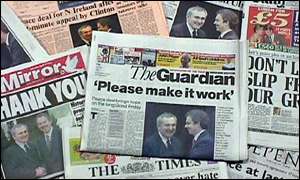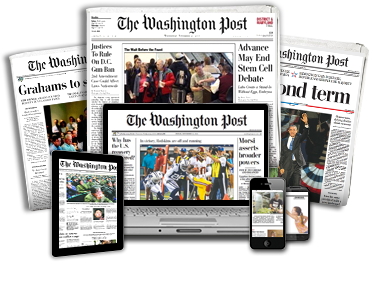This is the weekend edition of TheMarioBlog and will be updated as needed. The next blog post will be Monday, February 15.
Update #1: Friday, Feb. 12, 07:41


Print in the UK: still strong with 7 million copies sold daily, but down from 13 million 10 years ago

“The best news in US newspapers in recent years may be Amazon founder Jeff Bezos’s purchase of the Washington Post in 2013”
Call like it is is how I would summarize this lengthy and fact-filled piece from the Financial Times about how the media fares in the UK today, which, by the way, is not a very different picture of how things are elsewhere.
Typical of the Financial Times, the article includes many graphics depicting the financial status of the major UK media companies with highlights that are not at all surprising or unique, as we compared them to numbers recently released by The New York Times, for example.
–Changing platforms: Total internet revenue is up, while print revenue is down.
–Print newspaper consumption in the UK: still strong with 7 million copies sold daily, but down from 13 million 10 years ago.
What I found interesting, however, is an overall impression from several experts quoted in the piece that newspaper managers need to stop thinking of models of the past, tha the historic models that made newspapers profitable in the past are no longer useful. That the competition today is coming from such newcomers as Buzz Feed and Quartz.
“The industry needs to make a clear admission that the historic model for producing newspapers is bust,” says David Montgomery, former editor of the now defunct tabloid News of the World and until last year chief executive of regional publisher Local World. “Many in the industry are in denial.”
Indeed, denial is the appropriate word. It is denial based on a combination of factors, in my view. There are those who romanticize print, the golden days of newspapers, the glamour of an era of journalism that isn't anymore. Legacy is the elephant in the room, and not just for how we prepare news reports. It is also about business models, efforts to monetize, the marketing of the brands. Publishers need to realize that while the print model continues to be static, the digital platforms continue to evolve—and rapidly.
The good news from this FT piece: titles are experimenting.
“With no single answer, a conservative industry is starting to consolidate and experiment. Trinity Mirror has bought control of regional newspaper group Local World for £187m in an attempt to reduce costs and offer advertisers nationwide coverage. The Sun is launching an online betting site. The Guardian is expanding a membership scheme under which readers can pay between £5 and £60 a month to support the paper and attend events.
“For the Sun and the Guardian, the strategy is clear: traffic alone may not generate revenues, but it may provide a captive audience for ecommerce and even micropayments, where readers pay for access to individual articles.”
The article makes reference to experimentation at The Washington Post since Jeff Bezos acquired the iconic newspaper.
The best news in US newspapers in recent years may be Amazon founder Jeff Bezos’s purchase of the Washington Post in 2013. On top of the $250m he paid for the Post, he has pumped millions into the search for a sustainable business model.
How readers get to us has changed
An article about the current state of the media could not ignore what I consider to be the most important topic: how readers access our content. Newspapers are rapidly losing their direct digital route to their readers. Readers of this blog know how I feel about the home pages and how they are losing their effectiveness, with readers coming into our content via social media.
“Five years ago news groups were trying to ignore Facebook and Google. Now they are facing the inevitable,” says Will Perrin, director of internet consultancy Talk About Local. “In the next five years it will be all about distribution — what is your relationship like with Facebook and Google?”
Smart publishers do what The Financial Times is already doing by participating in Apple News, Facebook Instant Articles and Google initiatives. The FT piece mentions that there is even a possibility that Facebook, Apple and others could pay news publishers to carry their content, just as cable providers pay to carry particular channels. In fact, this would increase monetizing opportunities beyond the traditional revenue avenues of subscriptions and advertising.
The most optimistic message of this FT piece comes at the end, with a quote from David Montgomery a former editor of the News of the World newspaper:
“The effort that has gone into (online) has always had one eye on the past. I think we're getting to the end of that road now.”
Using the print model, not just for how revenue is produced, but also how the news is presented is counterproductive and even toxic. I find it refreshing to hear and to see that, finally, publishers are looking at the digital platforms and experimenting with how they can be best utilized, leading to innovative storytelling and , hopefully, new monetizing strategies.
Quarts on your iPhone now
One of our favorite news outlets, Quartz, now has a new iPhone app. It's live in the App Store right now.
The app, exclusive to iPhone, is a whole new way to experience Quartz. We put aside existing notions about news apps and imagined what our journalism would be if it lived natively on your iPhone. It wouldn’t be a facsimile of our website. It would be something entirely different, with original writing, new features, and a fresh interface.